The dark stuff of our universe
Expert reviewers
Professor Brian Schmidt AC FRS FAA
Professor of Astronomy, Research School of Astronomy & Astrophysics
Australian National University
Essentials
- Around 25 per cent of our universe is made of dark matter, and around 70 per cent is dark energy.
- We don't know much about the dark matter particle and we can't see it directly, but it has no electrical charge and concentrates in galaxies and clusters.
- The universe itself is expanding at an accelerating rate, and this is where dark energy comes in. It is the fuel that 'pushes' the universe apart.
- Like dark matter, dark energy is largely a mystery to us, and researchers are currently investigating it.
Matter as we know it, atoms and stars and galaxies and planets and trees and rocks and, us, amount for less than 5 per cent of the known universe. The rest remains somewhat of a mystery. A dark one.
Astronomers and cosmologists think around 25 per cent of our universe is made of something called dark matter, and the remainder, around 70 per cent, is what’s known as dark energy.
Dark matter
We can’t see dark matter—it doesn’t interact with light. The only reason we know there’s something out there beyond what we can directly see is because of the way it interacts with gravity.
The speed at which an object will move in space depends on the gravitational field in which it resides, and gravitational fields depend upon mass. In 1933, the astronomer Fritz Zwicky observed that galaxies within the Coma cluster were moving faster than expected; speeds which should have caused them to leave the cluster rather than being held in by its gravitational pull. Some years later, Ken Freeman noticed gas was moving around galaxies at greater and greater distances yet remaining at the same speed. This was occurring despite there being little material at the large distances. Vera Rubin saw the same thing with stars on the edges of many galaxies.
These observations implied that the gravitational fields in these galaxies were greater than expected based on their amount of (visible) mass, and could only be explained by the presence of some sort of additional mass. Our best guess as to where this mass comes from is that it’s some sort of strange new exotic particle: dark matter.
No one knows much about this particle, except to be pretty sure it’s something we’ve never encountered before here on Earth. It doesn’t interact with light, hence the name ‘dark’ matter, which means that it’s neutral, with no electrical charge. It concentrates in galaxies and clusters, rather than being dispersed evenly throughout space, which means that it is slow moving.
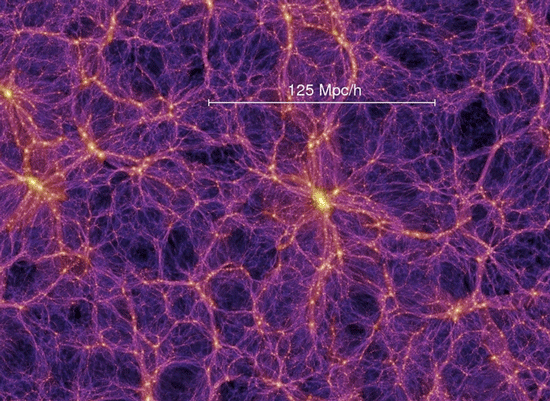
Dark energy
The expanding universe
In the 1920s, the American astronomer Edwin Hubble examined how the wavelength of electromagnetic radiation emitted by distant galaxies becomes stretched into a longer wavelength—it ‘shifts’ towards the red end of the electromagnetic spectrum as it travels through space. He found that fainter, more distant, galaxies showed a large degree of redshift GLOSSARY redshiftThe effect of electromagnetic radiation emitted by an object increasing in wavelength, down the 'red' end of the spectrum, as it travels away from us in space. ; closer galaxies, not so much. Hubble determined that this was because the universe itself is expanding—the redshift occurs because the wavelengths of light are stretched as the universe expands.
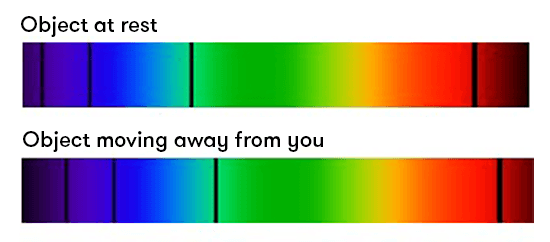
The degree of redshift can be translated into an apparent velocity—the further away a galaxy is from us, the faster it appears to be moving. Using various measures to establish how far away the galaxies were, Hubble (and those that followed him) found that their redshift was always proportional to their distance. The ratio of the two became the famous ‘Hubble constant’ and represents the expansion rate of the universe.
But now we have evidence that the Hubble ‘constant’ is not really constant. In the late 1990s, two teams, one led by Australian astronomer Brian Schmidt, the other by American Saul Perlmutter, each measured the brightness and redshift of many (52 in total between the two teams) distant examples of a certain type of exploding star (type Ia supernovae). Both teams came to the same result: rather than gravity exerting its pull and reigning in the expansion of the universe, it was in fact expanding at an accelerating rate. Their findings earned them, along with Adam Riess, the 2011 Nobel Prize in Physics.
Their extraordinary discovery suggests that there is something causing the expansion of the universe to speed up. And this is where dark energy comes in. One idea is that as the universe expands, and ‘normal’ matter and radiation becomes more dilute, the density of dark energy remains constant—it doesn’t dissipate. So, as space gets bigger, in order for the density of the dark energy to remain the same, more and more of it is created. It serves as the fuel that ‘pushes’ the universe apart.
This starts to sound remarkably similar to an idea that Einstein had in 1917. In order to make his new theory of general relativity work, he assigned a value to the ‘energy density’ of empty space, proposing an unseen influence which counteracted the pull of gravity upon all the matter in the universe, so that gravity didn’t cause the universe to eventually collapse in upon itself. He called it the ‘cosmological constant’.
In 1917 Einstein didn't realise the universe was expanding, and he later gave up the concept of the cosmological constant as a bad idea once Hubble's discovery of the expansion of the universe was made public 12 years later. However, if we accept Einstein’s idea of the energy of empty space (now called ‘vacuum energy’) using the laws of quantum mechanics we can actually calculate how much of it there should be. The answer turns out to be ridiculously wrong, around 10120 times the observed amount. Obviously, we’re still missing something.
One other piece in this puzzle comes from the shape, or geometry of the universe. Another of Einstein’s observations is that the shape of the universe depends upon its density. Cosmologists have been able to measure the ‘flatness’ of the universe by examining fluctuations in a type of radiation known as the Cosmic Microwave Background, but the total amount of matter (both ‘normal’ and dark) doesn’t provide enough density to match their observations. The rest must come from somewhere, and it just happens that the amount of dark energy required to explain the acceleration of the expansion of the universe is also the right amount to also provide the observed flatness of space.
Along with exploding stars and stretching of light as it travels through an expanding universe, there are some other methods that astronomers use to probe the mysteries of dark matter and dark energy.
Cosmic Microwave Background
and baryon acoustic oscillations
The Cosmic Microwave Background is a whisper of radiation that reaches detectors on Earth from all over the sky. When the CMB was set loose, only 400,000 years after the Big Bang, the universe was very hot and dense and the CMB took the form of light similar to that produced by a light bulb. Now, more than 13 billion years later, the universe has expanded and cooled so much that the CMB has mostly been reduced to a gentle wash of microwaves, not unlike those that power your microwave oven.
The CMB is almost, but not exactly, the same whichever direction we look. Pictures constructed from satellite data show very subtle variations in the strength of the microwave signal. These hot spots and cold spots, which differ in temperature by only millionths of a degree, can be interpreted as very slight differences in the crowding together of matter in the young universe. Hot spots have slightly more matter than average; cold spots a bit less.
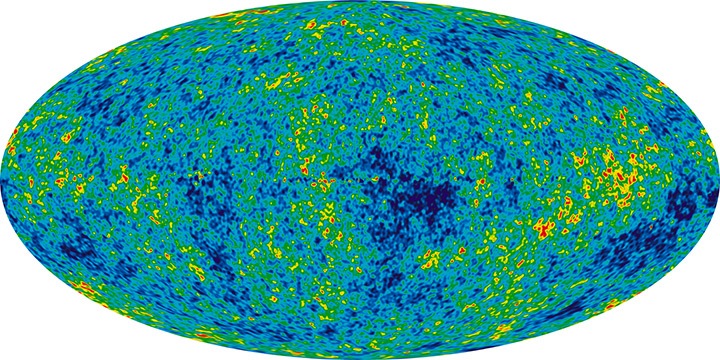
These temperature differences seem to have a certain regularity, with peaks and troughs recurring in a detectable rhythm. The popular explanation for these fluctuations is that they come from a sort of sound wave that echoed around the early universe. Back then, matter had not yet formed into atoms. Instead we had a plasma of protons, neutrons and related particles, collectively called baryons. The sound waves left their imprint in the distribution of this early matter. So we can talk about ‘acoustic baryon waves’ or more informally ‘baryonic wiggles’.
By examining the imprint of these wiggles, astronomers can build a template for how the modern universe was formed, with the hot spots becoming the seeds of super-clusters of galaxies and the cold spots giving rise to relative voids. The distribution of galaxies today can be compared with patterns in the CMB, and the difference between the two patterns should depend how dark energy has affected the expansion of the universe.
Galaxy clustering
The depths of the universe hold uncountable numbers of galaxies, huge congregations of stars similar to our own Milky Way galaxy. We know these are not scattered at random. In some parts of the cosmos galaxies crowd together in clusters and even superclusters. Elsewhere, the universe seems relatively empty of galaxies, creating voids which have been likened to soap bubbles.
The way in which galaxies cluster is affected by both the expansion of the universe, and the way that gravity interacts with dark energy. Examining the patterns of galaxy clusters and how they change over time and how they relate to patterns in the CMB can provide insights into the fundamental structure of the universe.
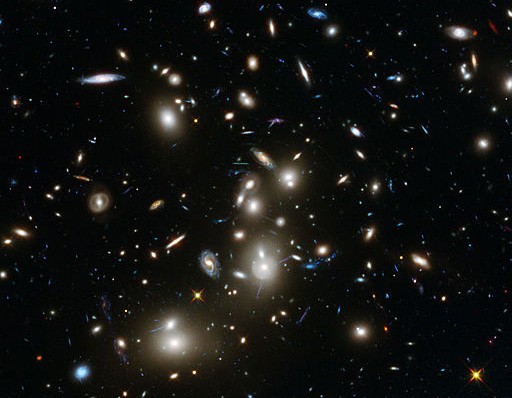
Gravitational lensing
A process called gravitational lensing describes how gravity distorts light, and in particular, how massive objects in the universe distort the light from distant galaxies as it passes by them. Strong gravitational lensing can actually result in such strongly bent light that multiple images of the light-emitting galaxy are formed.
Weak gravitational lensing results in galaxies appearing distorted, stretched or magnified. Although difficult to measure for an individual galaxy, galaxies clustered close together will exhibit similar lensing patterns.
Analysing the nature of gravitational lensing patterns tells astronomers about the way dark matter is distributed within galaxies and their distance. This method provides a probe for investigating both the development of structure in the universe and the expansion of the universe.
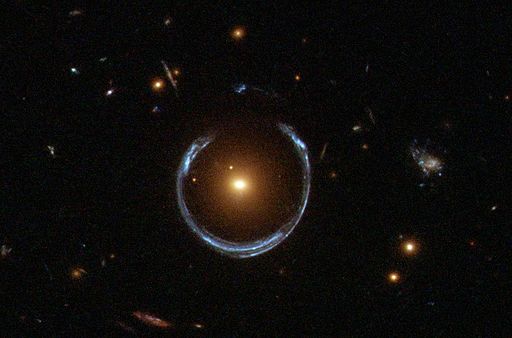
Current research
There are a number of projects currently investigating the mysteries of dark energy around the world. Australian scientists are contributing to several of these using the Anglo-Australian Telescope at the Siding Spring Observatory near Coonabarabran, New South Wales. By measuring how light is bent by the force of gravity in space, we are contributing to our understanding of how dark matter and dark energy behave.
A project called 2dFLenS will survey 100,000 galaxies to investigate the physics of gravity in space by examining how gravitational lensing affects the velocities and shapes of the galaxies.
The OzDES (Australian Dark Energy Survey) project goal is to measure the redshifts of tens of thousands of galaxies and the spectra of more than 3,000 supernovae. This will take 100 nights of telescope time over the duration of the 5-year project. Considering that the study of around 52 supernovae led to a Nobel Prize-winning discovery, it’s pretty exciting to think of what questions might be answered after crunching the data from more than 3,000 of the exploding stars.
OzDES is part of a larger project, the Dark Energy Survey, an international collaboration of more than 120 scientists from 23 different institutions being conducted at the Cerro Tololo Inter-American Observatory in Chile. This team are taking pictures of the night sky over 525 nights using a purpose-built 570 mega-pixel (your smartphone most likely has somewhere between 8 and 16 mega-pixels) camera, mounted on a 4-metre telescope. This project intends to take measurements from 300 million galaxies as well as thousands of supernovae. Using a combination of complementary methods, including analysis of Type Ia supernovae, baryon acoustic oscillations, galaxy clustering and weak gravitational lensing, the team’s primary mission is to investigate what is causing cosmic acceleration, and if Einstein’s theory of general relativity still holds true on cosmic scales, or do we need a new theory of gravity? Stay tuned. Results are due 2018.
We have made astronomical progress, one jigsaw piece at a time, in building our understanding of our universe: its structure, how it formed and what it’s made of. Clearly, though, astronomers, astrophysicists and cosmologists aren’t going to be out of a job anytime soon. It seems most likely that the puzzle we’re completing, will, like our universe, keep growing and expanding. It’s a jigsaw with no corners or straight edges—no constraints upon the new insights and understandings that become apparent as we fit each piece to the next.





